The Lean Canvas Model is a powerful tool for entrepreneurs and startups looking to streamline their business planning process. It simplifies complex business models into a single page, allowing for quick iterations and adjustments. This guide explores the importance of the Lean Canvas Model, provides real-world examples of its success, and offers practical steps for creating your own Lean Canvas. By the end of this article, you'll understand why the Lean Canvas Model is essential for modern businesses and how you can leverage it to enhance your entrepreneurial journey.
Why Should You Use a Lean Canvas Template?
The Lean Canvas Template is designed to provide a clear and concise overview of a business model, making it an invaluable resource for entrepreneurs. Here are some compelling reasons to use a Lean Canvas Template:
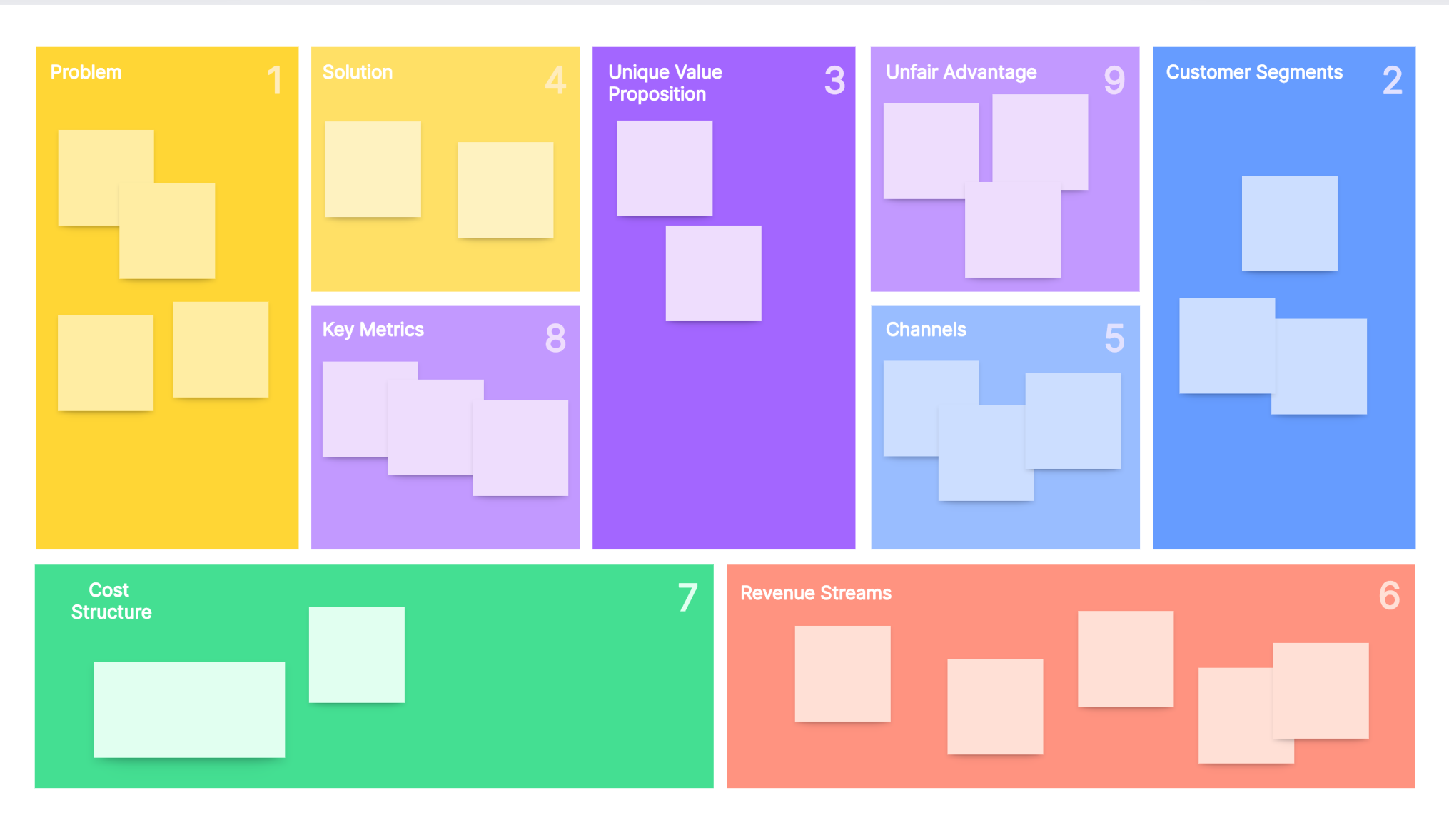
1. Simplifies Complex Ideas
The Lean Canvas condenses your entire business plan into a single page, making it easier to communicate complex ideas quickly. This simplicity is especially useful for startups that need to pivot and adapt rapidly based on feedback and market conditions.
2. Encourages Focus on Key Metrics
By focusing on critical aspects such as problem, solution, key metrics, and unique value proposition, the Lean Canvas helps entrepreneurs prioritize what's essential. This focus can lead to more effective decision-making and resource allocation.
3. Facilitates Collaboration
A Lean Canvas Template is an excellent tool for team collaboration. It provides a visual representation of the business model that can be easily shared and discussed with team members, investors, and advisors. This collaborative approach ensures that everyone is aligned and working towards the same goals.
4. Promotes Iteration and Adaptability
The Lean Canvas is designed for iteration. As new information is gathered and market conditions change, the canvas can be quickly updated to reflect new strategies and insights. This adaptability is crucial for startups in dynamic industries.
Businesses Succeeded with the Lean Canvas Model
The Lean Canvas Model has been instrumental in the success of many businesses across various industries. Here are a few examples:
1. Dropbox
Dropbox, a file storage and sharing service, used the Lean Canvas Model to refine its business model during its early stages. By focusing on key problems such as limited storage space and the need for easy file sharing, Dropbox was able to develop a unique value proposition that resonated with users. This focus allowed them to grow rapidly and become a market leader.
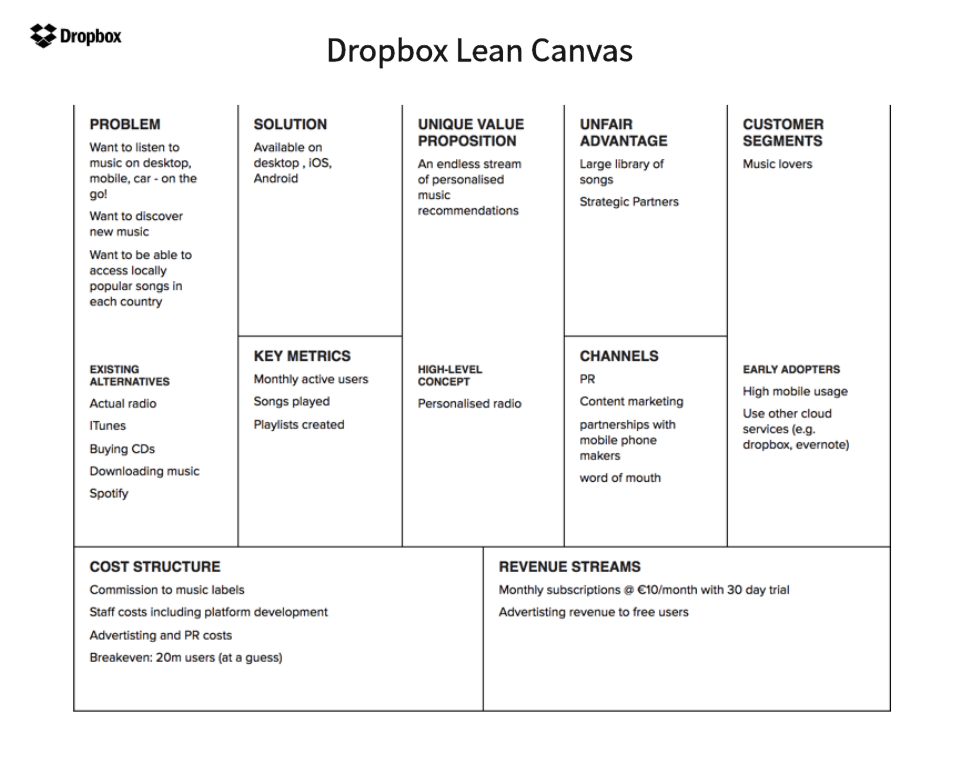
Challenge: In its early stages, Dropbox faced the challenge of convincing users to switch from traditional storage methods to a cloud-based solution. The market was already filled with established competitors, making it crucial for Dropbox to clearly define its value proposition and user benefits.
Solution: Using the Lean Canvas Model, Dropbox focused on identifying and solving specific problems that users faced with existing storage solutions. Key problems included limited storage space, difficulty in sharing files, and the need for a seamless user experience.
Execution: Dropbox's Lean Canvas highlighted its unique value proposition: providing a simple, efficient, and reliable cloud storage solution. By targeting early adopters and offering a free storage tier, Dropbox was able to quickly build a user base and demonstrate its value.
Outcome: Dropbox’s clear focus on solving user problems and its effective use of the Lean Canvas Model led to rapid growth. Today, Dropbox is a leading player in the cloud storage industry with millions of users worldwide.
2. Airbnb
Airbnb leveraged the Lean Canvas Model to disrupt the traditional hospitality industry. By identifying the problem of expensive and impersonal hotel experiences, Airbnb created a solution that offered unique and affordable accommodations. The Lean Canvas helped them iterate their business model quickly, adapting to market needs and regulatory challenges.

Challenge: The founders of Airbnb needed to disrupt the traditional hospitality industry and overcome significant trust barriers between hosts and guests.
Solution: The Lean Canvas Model helped Airbnb clearly define the key problems they were addressing: high cost of hotels, lack of authentic travel experiences, and the need for more lodging options during peak times.
Execution: Airbnb’s Lean Canvas focused on creating a platform that offered affordable, unique, and diverse accommodations. By emphasizing safety, user reviews, and secure transactions, Airbnb built trust within their community.
Outcome: Airbnb’s innovative approach and strategic use of the Lean Canvas Model allowed them to grow rapidly. They have become a dominant force in the travel industry, operating in over 220 countries and regions.
3. Uber
Uber utilized the Lean Canvas Model to revolutionize the transportation industry. By addressing problems like unreliable taxi services and the inconvenience of cash payments, Uber developed a solution that provided convenient, cashless rides at the tap of a button. The Lean Canvas allowed Uber to focus on critical aspects such as customer segments and cost structure, driving its rapid expansion.
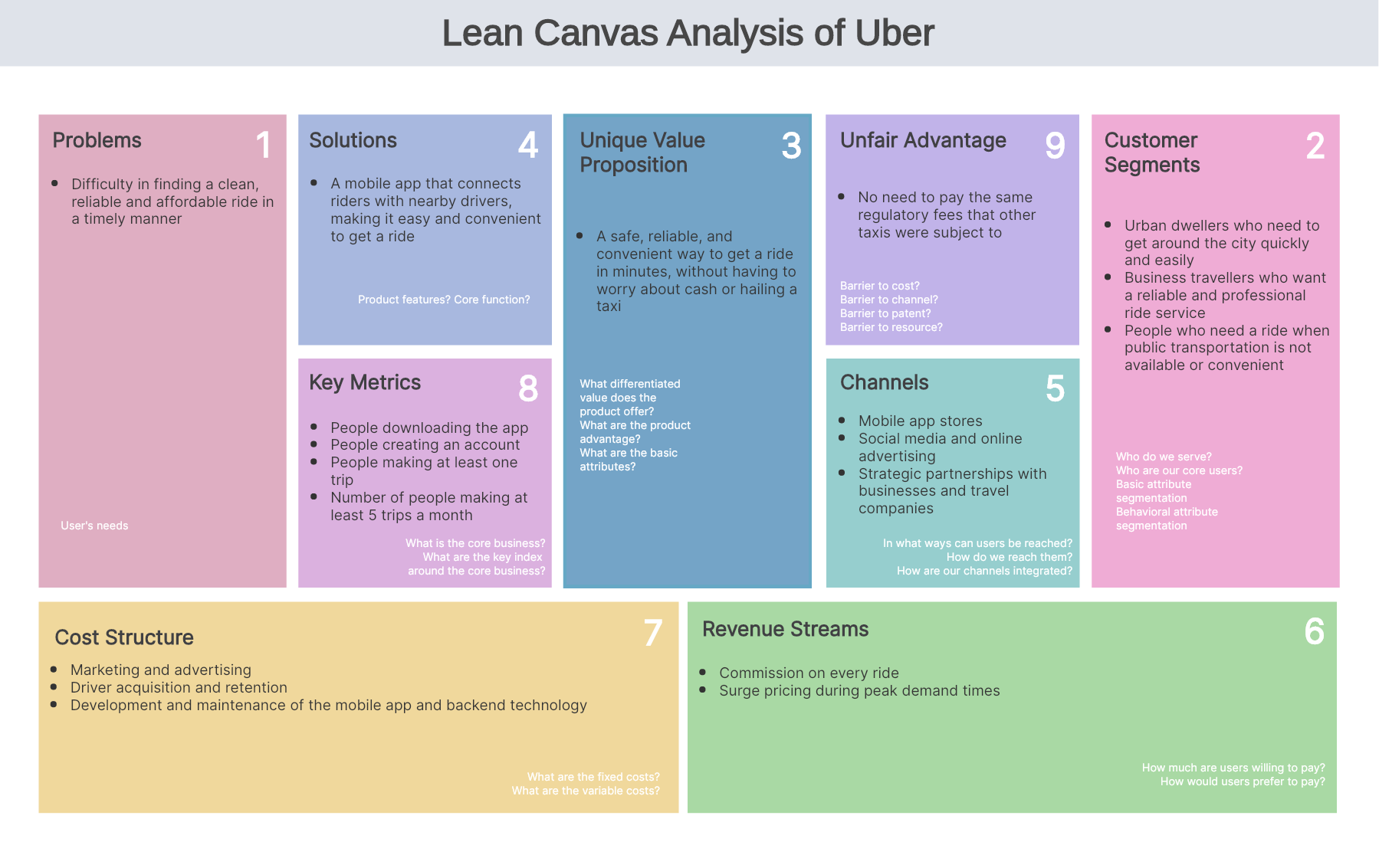
Challenge: Uber needed to address issues such as unreliable taxi services, long wait times, and the inconvenience of carrying cash.
Solution: The Lean Canvas Model enabled Uber to focus on these pain points and develop a solution that offered users a seamless and efficient ride-hailing experience. The canvas outlined their key strategies, including driver-partner recruitment, dynamic pricing, and customer feedback mechanisms.
Execution: Uber’s Lean Canvas emphasized the unique value proposition of reliable, affordable, and convenient transportation. They initially targeted tech-savvy urban dwellers and business travelers who valued efficiency and ease of use.
Outcome: Uber’s strategic use of the Lean Canvas Model led to explosive growth. The company expanded from a single city operation to a global phenomenon, fundamentally changing how people commute.
4. Buffer
Buffer is a social media management tool that helps users schedule posts, track performance, and manage multiple social media accounts from one platform.

Challenge: Buffer needed to stand out in a crowded market of social media tools by offering a product that addressed specific user needs and pain points.
Solution: The Lean Canvas Model allowed Buffer to focus on key problems such as the time-consuming nature of managing multiple social media accounts and the need for better content scheduling tools.
Execution: Buffer’s Lean Canvas highlighted their unique value proposition: a simple and intuitive platform that saves time and increases social media engagement. They focused on building a freemium model to attract users and gather valuable feedback.
Outcome: Buffer’s clear focus and iterative approach, guided by the Lean Canvas Model, helped them grow a loyal user base. Today, Buffer is a well-respected tool in the social media management space.
5. Lean Startup Machine
Lean Startup Machine is a company that offers workshops and resources to help entrepreneurs and startups apply lean startup methodologies.

Challenge: The challenge was to provide a practical, hands-on approach to learning and applying lean startup principles effectively.
Solution: The Lean Canvas Model was integral to Lean Startup Machine’s approach, helping participants quickly map out their business ideas and identify critical assumptions to test.
Execution: By using the Lean Canvas Model in their workshops, Lean Startup Machine provided a structured yet flexible framework that entrepreneurs could use to validate their ideas and iterate rapidly.
Outcome: Lean Startup Machine’s use of the Lean Canvas Model has helped thousands of entrepreneurs globally refine their business ideas and improve their chances of success.
Where to Find Free Lean Canvas Templates?
Finding the right Lean Canvas Template can set the foundation for your business planning. Here are some resources where you can find free Lean Canvas Templates:
1. Boardmix
Boardmix offers a variety of customizable Lean Canvas Templates that are easy to use and tailor to your specific needs. These templates come with pre-defined sections, making it simple to fill out and modify as your business evolves.
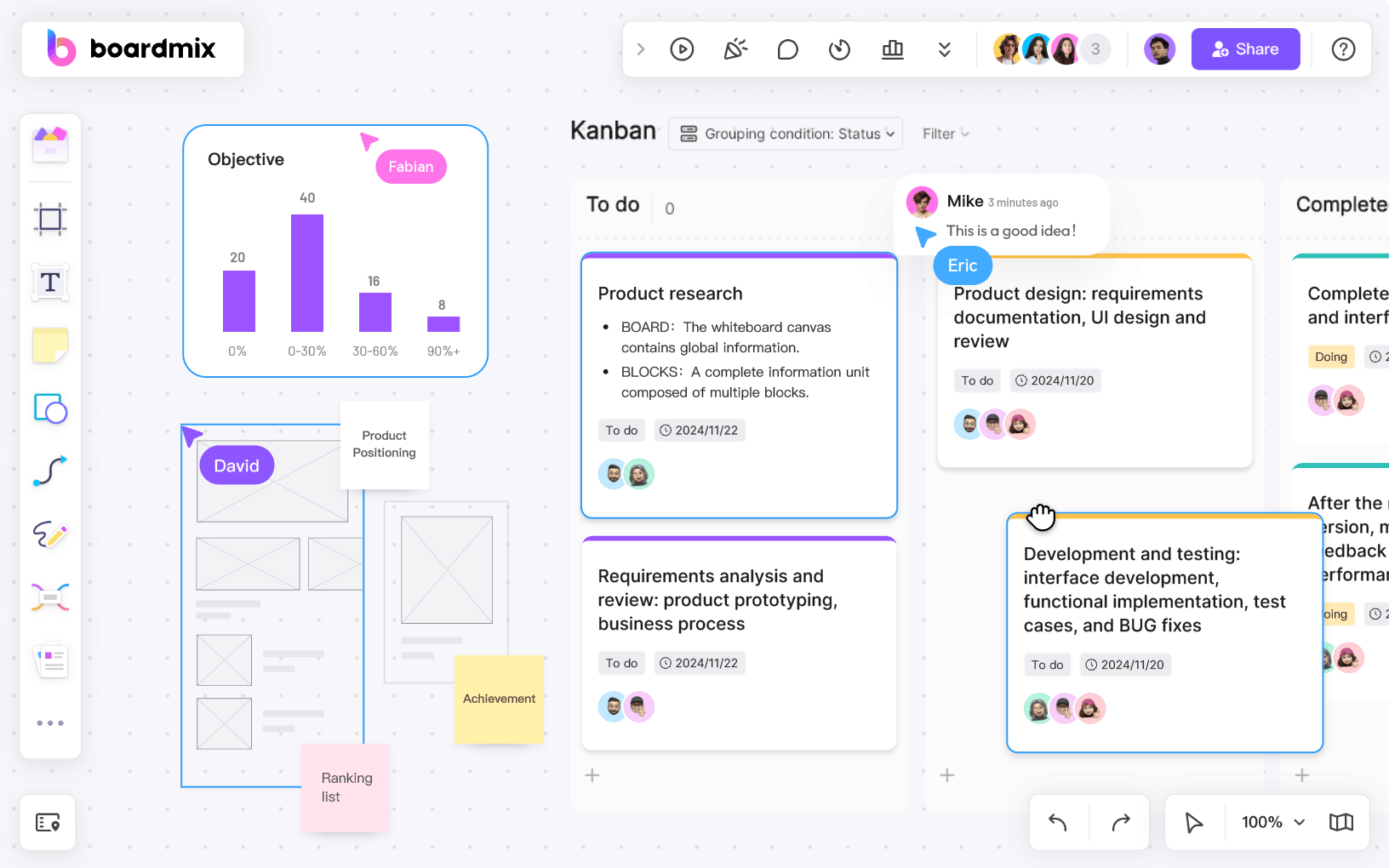
2. Leanstack
Leanstack, created by the author of Lean Canvas, Ash Maurya, offers free templates along with additional resources and tools to help you create and refine your Lean Canvas.
3. Pinterest
Pinterest is a great source of inspiration for Lean Canvas Templates. You can find a variety of designs and formats shared by other entrepreneurs and business coaches.
4. Google Docs and Sheets
Google Docs and Sheets offer free Lean Canvas Templates that you can easily duplicate and customize. These templates are great for collaboration, allowing you to share and edit with team members in real-time.
How to make a Lean Canvas in Boardmix?
Creating a Lean Canvas in Boardmix is straightforward and efficient. Here’s a step-by-step guide:
Step 1: Sign Up for Boardmix
Visit the Boardmix website and sign up for a free account. You can use your email or social media accounts for quick registration, Users should navigate to the template library once logged in, and use the search bar to find Lean Canvas Templates quickly.
Step 2: Select a Lean Canvas Template
Choose a Lean Canvas Template that suits your needs, and look for templates with clear sections for problem, solution, key metrics, unique value proposition, and other essential elements.
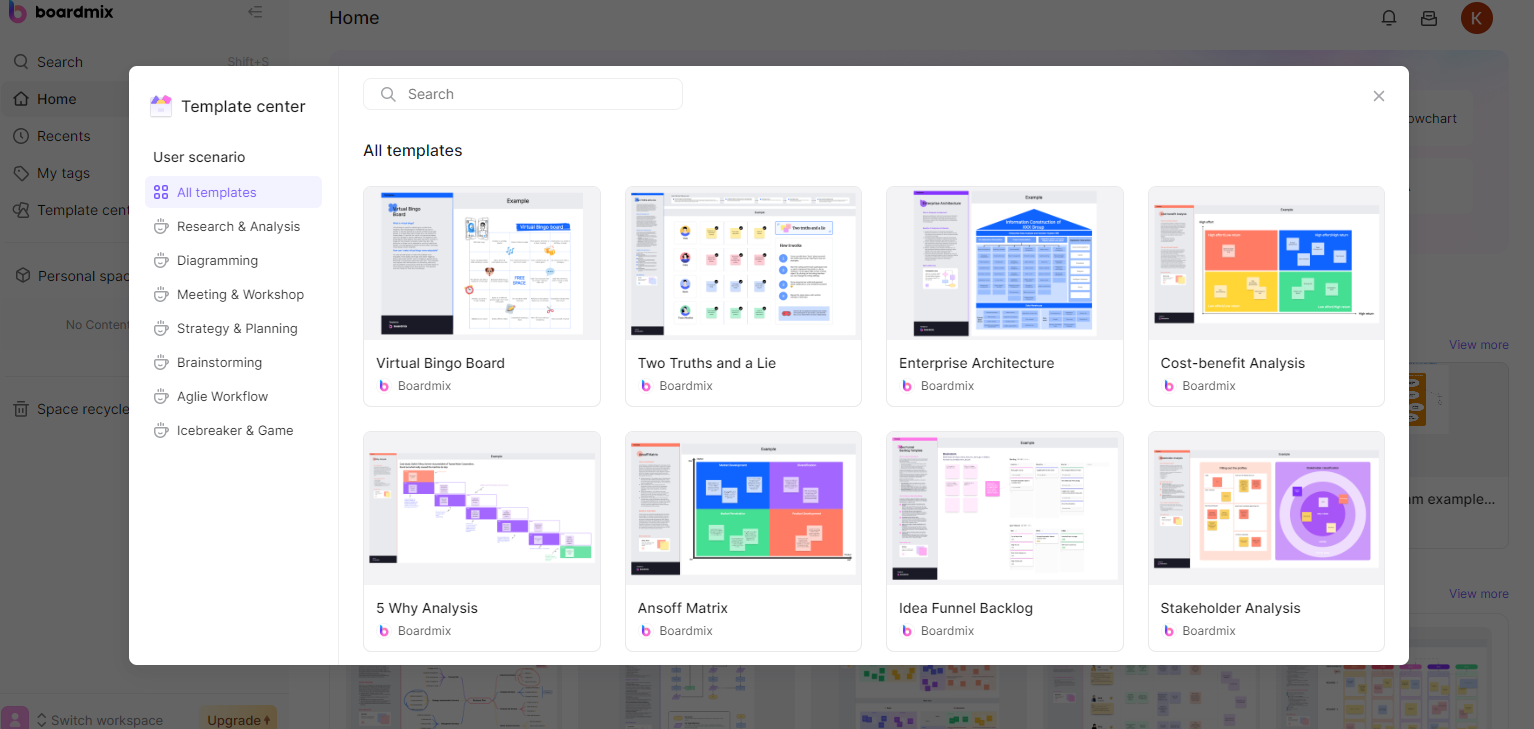
Step 3: Customize the Template
Open the template in the Boardmix editor and start customizing it. Fill in each section with relevant information about your business model. Use bullet points or concise statements for clarity.

Step 4: Collaborate with Your Team
Share the template with your team members for feedback and collaboration, and use Boardmix’s collaboration features to allow team members to edit and comment on the canvas.
Step 5: Iterate and Refine
Regularly update and refine your Lean Canvas as you gather more information and feedback. Set aside time each week to review and adjust your canvas based on new insights and market conditions.
The Lean Canvas Model is a valuable tool for entrepreneurs and startups looking to streamline their business planning process. By using a Lean Canvas Template, you can simplify complex ideas, focus on key metrics, and promote collaboration within your team.
By following the steps outlined in this guide, you can create a personalized Lean Canvas that helps you navigate the challenges of entrepreneurship and achieve your business goals. Embrace the power of the Lean Canvas Model to transform your business strategy and take your entrepreneurial journey to new heights.








